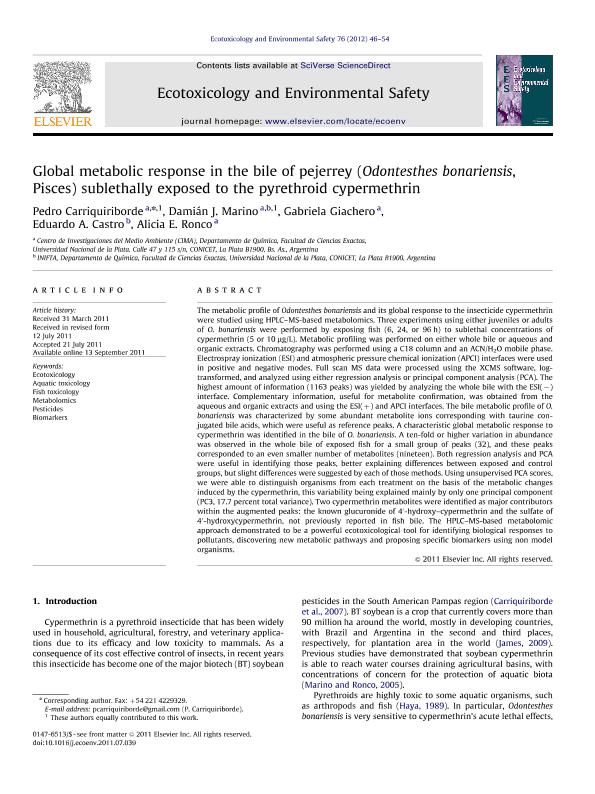Mostrar el registro sencillo del ítem
dc.contributor.author
Carriquiriborde, Pedro

dc.contributor.author
Marino, Damian Jose Gabriel

dc.contributor.author
Giachero
dc.contributor.author
Castro, Eduardo Alberto

dc.contributor.author
Ronco, Alicia Estela

dc.date.available
2019-05-17T21:33:54Z
dc.date.issued
2012-02
dc.identifier.citation
Carriquiriborde, Pedro; Marino, Damian Jose Gabriel; Giachero; Castro, Eduardo Alberto; Ronco, Alicia Estela; Global metabolic response in the bile of pejerrey (Odontesthes bonariensis, Pisces) sublethally exposed to the pyrethroid cypermethrin; Academic Press Inc Elsevier Science; Ecotoxicology and Environmental Safety; 76; 1; 2-2012; 46-54
dc.identifier.issn
0147-6513
dc.identifier.uri
http://hdl.handle.net/11336/76682
dc.description.abstract
The metabolic profile of Odontesthes bonariensis and its global response to the insecticide cypermethrin were studied using HPLC-MS-based metabolomics. Three experiments using either juveniles or adults of O. bonariensis were performed by exposing fish (6, 24, or 96h) to sublethal concentrations of cypermethrin (5 or 10μg/L). Metabolic profiling was performed on either whole bile or aqueous and organic extracts. Chromatography was performed using a C18 column and an ACN/H2O mobile phase. Electrospray ionization (ESI) and atmospheric pressure chemical ionization (APCI) interfaces were used in positive and negative modes. Full scan MS data were processed using the XCMS software, log-transformed, and analyzed using either regression analysis or principal component analysis (PCA). The highest amount of information (1163 peaks) was yielded by analyzing the whole bile with the ESI(-) interface. Complementary information, useful for metabolite confirmation, was obtained from the aqueous and organic extracts and using the ESI(+) and APCI interfaces. The bile metabolic profile of O. bonariensis was characterized by some abundant metabolite ions corresponding with taurine conjugated bile acids, which were useful as reference peaks. A characteristic global metabolic response to cypermethrin was identified in the bile of O. bonariensis. A ten-fold or higher variation in abundance was observed in the whole bile of exposed fish for a small group of peaks (32), and these peaks corresponded to an even smaller number of metabolites (nineteen). Both regression analysis and PCA were useful in identifying those peaks, better explaining differences between exposed and control groups, but slight differences were suggested by each of those methods. Using unsupervised PCA scores, we were able to distinguish organisms from each treatment on the basis of the metabolic changes induced by the cypermethrin, this variability being explained mainly by only one principal component (PC3, 17.7 percent total variance). Two cypermethrin metabolites were identified as major contributors within the augmented peaks: the known glucuronide of 4'-hydroxy-cypermethrin and the sulfate of 4'-hydroxycypermethrin, not previously reported in fish bile. The HPLC-MS-based metabolomic approach demonstrated to be a powerful ecotoxicological tool for identifying biological responses to pollutants, discovering new metabolic pathways and proposing specific biomarkers using non model organisms.
dc.format
application/pdf
dc.language.iso
eng
dc.publisher
Academic Press Inc Elsevier Science

dc.rights
info:eu-repo/semantics/openAccess
dc.rights.uri
https://creativecommons.org/licenses/by-nc-nd/2.5/ar/
dc.subject
Aquatic Toxicology
dc.subject
Biomarkers
dc.subject
Ecotoxicology
dc.subject
Fish Toxicology
dc.subject
Metabolomics
dc.subject
Pesticides
dc.subject.classification
Ciencias Medioambientales

dc.subject.classification
Ciencias de la Tierra y relacionadas con el Medio Ambiente

dc.subject.classification
CIENCIAS NATURALES Y EXACTAS

dc.title
Global metabolic response in the bile of pejerrey (Odontesthes bonariensis, Pisces) sublethally exposed to the pyrethroid cypermethrin
dc.type
info:eu-repo/semantics/article
dc.type
info:ar-repo/semantics/artículo
dc.type
info:eu-repo/semantics/publishedVersion
dc.date.updated
2019-05-08T17:18:56Z
dc.journal.volume
76
dc.journal.number
1
dc.journal.pagination
46-54
dc.journal.pais
Estados Unidos

dc.description.fil
Fil: Carriquiriborde, Pedro. Universidad Nacional de La Plata. Facultad de Ciencias Exactas. Departamento de Química; Argentina. Consejo Nacional de Investigaciones Científicas y Técnicas; Argentina
dc.description.fil
Fil: Marino, Damian Jose Gabriel. Universidad Nacional de La Plata. Facultad de Ciencias Exactas. Departamento de Química; Argentina. Consejo Nacional de Investigaciones Científicas y Técnicas; Argentina
dc.description.fil
Fil: Giachero. Universidad Nacional de La Plata. Facultad de Ciencias Exactas. Departamento de Química; Argentina
dc.description.fil
Fil: Castro, Eduardo Alberto. Consejo Nacional de Investigaciones Científicas y Técnicas. Centro Científico Tecnológico Conicet - La Plata. Instituto de Investigaciones Fisicoquímicas Teóricas y Aplicadas. Universidad Nacional de La Plata. Facultad de Ciencias Exactas. Instituto de Investigaciones Fisicoquímicas Teóricas y Aplicadas; Argentina
dc.description.fil
Fil: Ronco, Alicia Estela. Universidad Nacional de La Plata. Facultad de Ciencias Exactas. Departamento de Química; Argentina. Consejo Nacional de Investigaciones Científicas y Técnicas; Argentina
dc.journal.title
Ecotoxicology and Environmental Safety

dc.relation.alternativeid
info:eu-repo/semantics/altIdentifier/doi/http://dx.doi.org/10.1016/j.ecoenv.2011.07.039
dc.relation.alternativeid
info:eu-repo/semantics/altIdentifier/url/https://www.sciencedirect.com/science/article/pii/S0147651311002570
Archivos asociados
